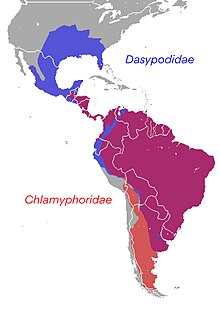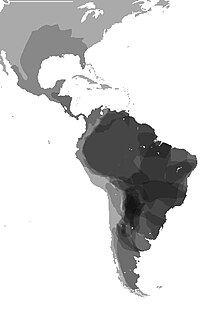Cingulata
| Cingulata | |
|---|---|

| |
Dasypus novemcinctus
| |
| Scientific classification | |
| Domain: | Eukaryota |
| Kingdom: | Animalia |
| Phylum: | Chordata |
| Class: | Mammalia |
| Superorder: | Xenarthra |
| Order: | Cingulata Illiger, 1811 |
| Families | |
| |

| |

| |
| The distribution and density of Cingulata species. | |
Cingulata, part of the superorder
The cingulate order originated in
Description
Armadillos have dorsal armor that is formed by osteoderms, plates of dermal bone covered in relatively small, overlapping keratinized epidermal scales called "scutes". Most species have rigid shields over the shoulders and hips, with three to nine bands separated by flexible skin covering the back and flanks.[9]
Pampatheres also had shells that were flexible due to three movable lateral bands of osteoderms.[3] The osteoderms of pampatheres were each covered by a single scute, unlike those of armadillos, which have more than one.[3] Glyptodonts, on the other hand, had rigid, turtle-like shells of fused osteoderms.
Both groups have or had a cap of armor atop their heads. Glyptodonts also had heavily armored tails; some, such as
Most armadillos
Classification


| Cladogram of Cingulata[11][12][13] | |||||||||||||||||||||||||||||||||||||||||||||||||||||||||||||||||||||||||||||||||||||||||||||
|
The taxonomic table below follows the results of a
Order Cingulata
- Family Ameghino 1894
- Genus Ameghino 1891
- Genus Ameghino 1904
- Genus Bordas 1938
- Genus Ameghino 1902
- Genus Ameghino 1887 (Horned armadillo)
- Genus Shockey 2017
- Family Ameghino 1895
- Genus Ameghino 1895
- Family
- Genus ? Ameghino 1902
- Genus Simpson 1930
- Genus Castellanos 1927
- Genus
- Genus Ameghino 1875 ex Gervais & Ameghino 1880
- Genus Edmund & Theodor 1997
- Genus †Tonnicinctus Góis et al. 2015[14]
- Genus Castellanos 1937]
- Genus Ciancio et al. 2012
- Family PachyarmatheriidaeFernicola et al. 2018
- Genus Carlini, Vizcaíno & Scillato-Yané 1997
- Genus Downing & White 1995
- Family Dasypodidae (long-nosed armadillos)
- Genus
- Genus
- Genus
- Genus
- Genus
- Genus
- Genus
- Genus
- Genus
- Genus
- Genus
- Genus
- Genus
- Genus
- Genus
- Genus
- Genus
- Genus
- Genus
- Genus
- Genus
- Genus
- Genus
- Genus
- Genus
- Genus
- Genus
- Genus
- Subfamily Dasypodinae
- Genus
- Genus Dasypus
- Genus
- Genus
- Genus
- Genus
- Genus
- Genus
- Family Chlamyphoridae: glyptodonts and other armadillos
- Subfamily Chlamyphorinae: fairy armadillos
- Genus Calyptophractus
- Genus Chlamyphorus
- Genus
- Subfamily Euphractinae: hairy, six-banded and pichi armadillos
- Genus Chaetophractus
- Genus
- Genus Euphractus
- Genus
- Genus
- Genus
- Genus
- Genus Zaedyus
- Subfamily Glyptodontinae: glyptodonts
- Genus
- Genus
- Genus
- Genus
- Genus
- Genus
- Genus
- Subfamily Tolypeutinae: giant, three-banded and naked-tailed armadillos
- Genus Cabassous
- Genus
- Genus Priodontes
- Genus Tolypeutes
- Subfamily Chlamyphorinae: fairy armadillos
References
- OCLC 62265494.
- ^ Giant Armadillo Priodontes maximus (Kerr, 1792). FaunaParaguay.com
- ^ S2CID 20186439.
- ^ PMID 19710060.
- ^ Mead, J. I.; Swift, S. L.; White, R. S.; McDonald, H. G.; Baez, A. (2007). "Late Pleistocene (Rancholabrean) Glyptodont and Pampathere (Xenarthra, Cingulata) from Sonora, Mexico" (PDF). Revista Mexicana de Ciencias Geológicas. 24 (3): 439–449 (see p. 440). Retrieved 2013-06-15.
- PMID 21125025.
- ISSN 0012-8252.
- OCLC 313368423.
- ISBN 978-0-87196-871-5.
- S2CID 129862616.
- ^ PMID 26906483.
- PMID 31800571.
- PMID 26556496.
- PMID 26083486.
- PMID 21288952.
